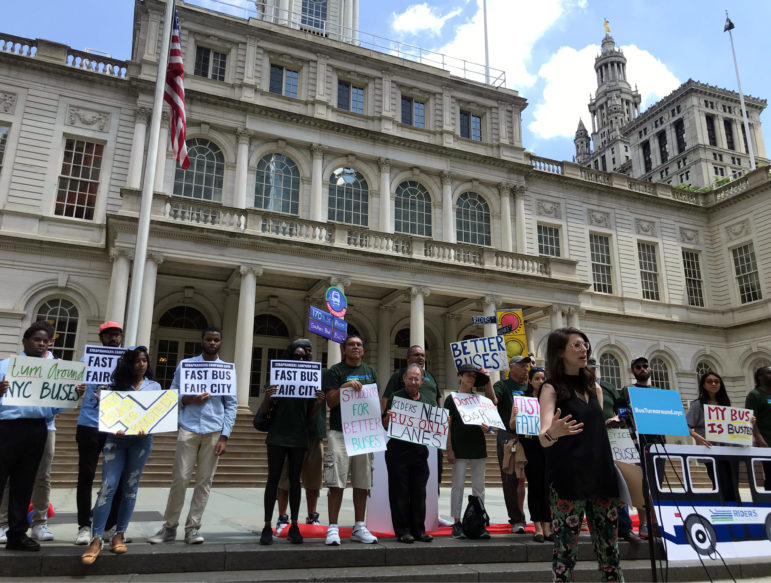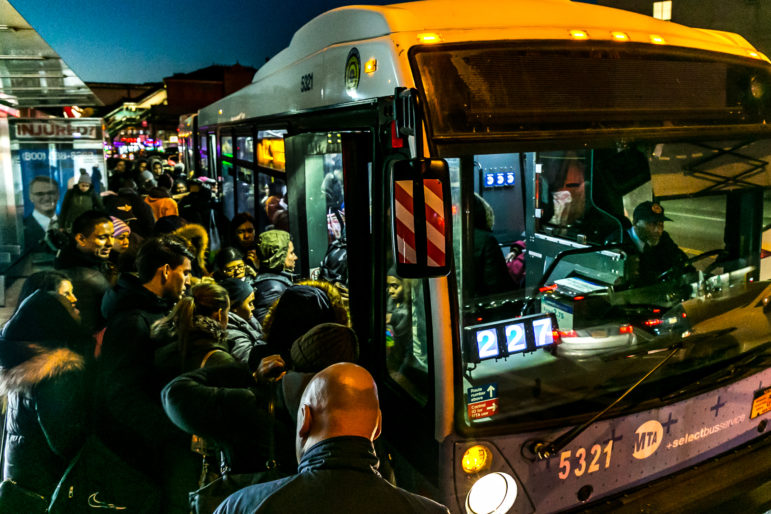
Yasmine Chokrane
While the city does plan improvements to the bus system, advocates say they are too little, too late to arrest a drop in ridership.
Transportation advocacy groups released a report Tuesday outlining ways Mayor de Blasio can fix the city’s sluggish bus system, with the goal of improving riders’ commutes in underserved neighborhoods with limited transit options.
The “Bus Turnaround” report, released by Riders Alliance, outlines specific actions the city can take to benefit its 2 million daily bus riders—stressing the de Blasio administration’s role in reforming the system, in addition to the Metropolitan Transportation Authority’s
“The buses are controlled by the MTA and the streets are controlled by the city—the streets, the traffic lights and the enforcement,” says Councilman Mark Levine. “We will not fix our bus system, we will not implement the Bus Turnaround plan, without the city doing its part.”
The MTA unveiled its own plan in April to improve city bus service, which is being used by fewer riders than in the past; ridership numbers are down 14 percent since 2007, according to the agency’s data. City buses are also notoriously slow, with an average speed of 6.7 miles per hour, the Riders Alliance’ report says.
“I’m a senior. I don’t know how much time I have left, and it seems like I’ve spent all my time waiting for the bus,” says Beth Childs, a “very frustrated” rider from the Upper East Side and a Riders Alliance member. She and other members performed a skit during a press conference in front of City Hall Tuesday, intended to draw attention to the daily struggles of bus riders.
Childs says she frequently takes the M15 bus because it’s hard for her to walk up and down the subway stairs.
“Even with knee and hip replacements, I can walk faster than that bus,” she says.
The report recommends adding 100 miles of bus lanes to New York City’s current 120, making sure bus lanes stay clear by ticketing cars that block them, and improving the experience of riders by establishing bus shelters and making accurate real-time information available to all.
It also calls for the city to expand its use of Transit Signal Priority (TSP), which adjusts traffic lights to prioritize buses moving through intersections. City buses spend 21 percent of their time in service waiting at red lights, according to the report. It recommends that the Department of Transportation quadruple the pace of its current TSP expansion to include all applicable intersections by 2020.
“I’ve had plenty of times where my bus trails behind red lights making me late and adding a dose of anxiety to my already stressful college lifestyle,” Smitha Varghees, a Straphangers Campaign member, said during Tuesday’s press conference.
She and other advocates say improving bus service is critical to de Blasio’s goal of an equitable New York: the city’s bus riders tend to be lower income-residents and people of color. The average bus rider earns $28,455 a year, compared to subway riders who earn an average of $40,000, according to the report, which cites Census data.
“We can’t be the fairest big city in America without dramatically better bus service,” says City Councilman Brad Lander.
When asked for comment, a spokesman for the mayor’s office said de Blasio agrees that bus service needs improvement.
“We have committed to improving our city’s bus system by expanding Select Bus Service, which is now up to 15 lines and serves 300,000 riders a day, and rolling out more dedicated bus lanes and other features to make bus trips more reliable and faster,” says Spokesman Seth Stein.
The Bus Turnaround report, however, calls Select Bus Service “an inadequate response to the systemwide crisis” because SBS routes are still too slow, with an average speed of 8.1 miles per hour, due in part to cars that block the lanes.
“It’s really simple—everybody’s competing for space but when you move 2 million trips a day in the buses of New York City, you’ve got to get dedicated lanes,” says J.P. Patafio, vice president of TWU Local 100. “They can give lanes to bikes—and we love bicyclists—you’ve got to give lanes to buses.”
The MTA is working on its own plan to revamp the bus network. The “Bus Action Plan,” released this spring, includes re-evaluating all of the city’s bus routes for potential changes and incorporating features like all-door boarding to speed up travel.
But advocates say those improvements won’t be enough without the city doing its part.
“The mayor needs to step up, get behind the plan, and put his political capital where his mouth is,” Patafio says.










One thought on “Transit Advocates Push Mayor on Bus Reforms”
The MTA has been studying the entire SI bus network since early 2016. Redesign of the SI express bus network was completed and the new routes will take effect on 8/19/2018. The SI local network redesign is ongoing but the MTA has not yet released any of it’s local bus proposals.
SI Express bus redesign – http://nymta.civicconnect.com/